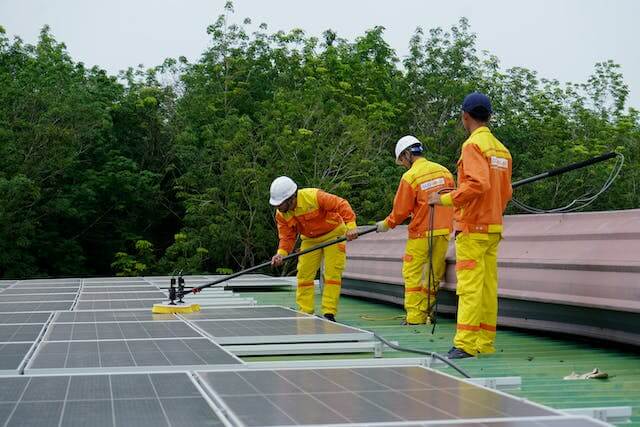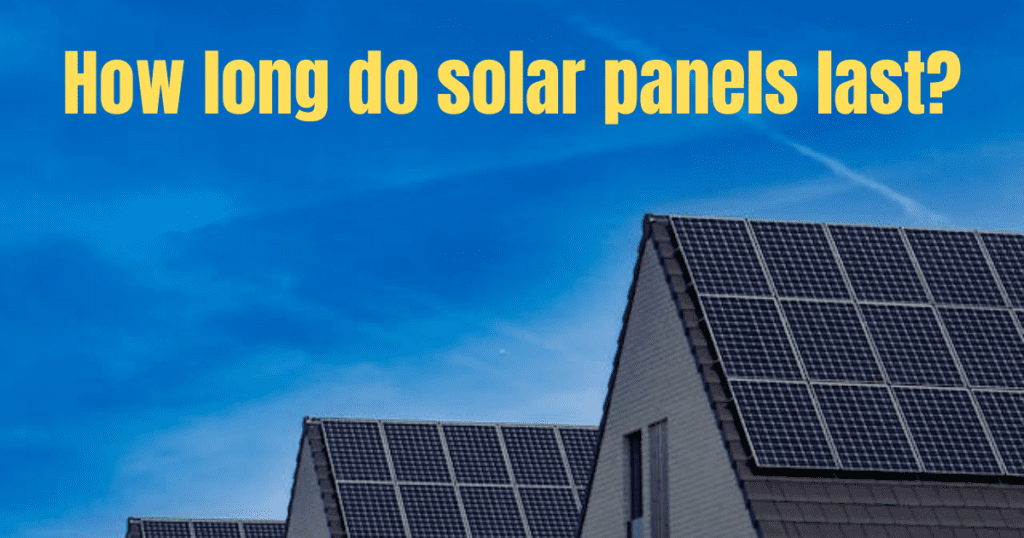Last updated on June 15th, 2024 at 05:03 am
Understanding the solar panel lifespan is pivotal for individuals and businesses alike, embarking on the renewable energy journey. Solar panels, with proper care and attention, can serve as reliable and sustainable sources of energy for decades.
Key considerations, such as the quality of manufacturing, environmental factors, and regular maintenance, play integral roles in maximizing their operational life.
In this article, we’ll provide you with a comprehensive overview of everything you need to know about the lifespan of solar panels. From understanding the factors influencing their lifespan to practical tips on maintenance and when to consider replacements, we’ve got you covered.
2. Solar panel degrades due to the several factors such as environmental endurance and extreme temperatures.
3. Solar panels degrades at a rate 0.3 to 1% per year
4. Regular upkeep and monitoring are crucial to maximize the lifespan of solar panels.
What is solar panel lifespan?
The lifespan of solar panels refers to the duration of time during which these photovoltaic (PV) systems are capable of producing electricity at an optimum level. It is a crucial metric in determining the overall efficiency and economic viability of solar energy installations.
Typically measured in years, the lifespan of solar panels is a key consideration for individuals, businesses, and organizations seeking to harness sustainable and renewable energy sources.

Importance of understanding solar panel lifespan and longevity
Understanding the solar panel lifespan is essential for various reasons. Firstly, it directly influences the return on investment for individuals and businesses investing in solar energy systems.
The longer the panels remain operational, the more cost-effective the investment becomes over time. Moreover, this knowledge aids in financial planning, allowing stakeholders to estimate the long-term economic benefits and sustainability of solar installations.
Beyond economic considerations, the environmental impact of solar panels is closely tied to their lifespan. Longer-lasting panels contribute to a more sustainable and eco-friendly energy landscape by reducing the need for frequent replacements and minimizing the associated manufacturing and disposal processes. Therefore, a comprehensive understanding of solar panel longevity is crucial for making informed decisions that align with both financial and environmental objectives.
How long do solar panels last?
The lifespan of solar panels, a pivotal consideration for those venturing into renewable energy, holds the key to sustainable power generation. On average, solar panels boast an operational lifespan ranging from 30 to 35 years, making them a robust and durable investment. This lifespan, however, is not a strict endpoint but rather an indication of the period during which the panels can maintain a specified level of performance.
While the average lifespan provides a general guideline, it is crucial to recognize that solar panels may continue to generate electricity beyond the initial estimates. Manufacturers often provide performance warranties guaranteeing that the panels will still produce a certain percentage of their original output after the stipulated lifespan. This warranty not only instills confidence in the longevity of the investment but also underscores the commitment of manufacturers to stand by the reliability of their products.
Solar panel degradation rate
Solar panel degradation rate is a critical metric that defines the annual reduction in the efficiency of photovoltaic (PV) panels as they age. This rate provides valuable insights into how much the performance of solar panels diminishes over time, influencing long-term energy yield projections and the overall economic viability of solar installations.
The typical industry-standard degradation rate for solar panels falls within the range of 0.3% to 1% per year. This means that, on average, solar panels are expected to lose half a percent to one percent of their initial efficiency annually. Over the standard 30-year lifespan of solar panels, this can lead to a cumulative degradation of approximately 9% to 30%.
Different types of solar panels exhibit varied degradation rates. Monocrystalline and polycrystalline panels, known for their sturdy construction, generally have lower degradation rates compared to thin-film panels. This variability underscores the importance of considering the specific type of solar panel when estimating long-term performance.
Manufacturers commonly provide performance warranties that include the degradation rate. These warranties assure users that the solar panels will maintain a specified level of efficiency over a predefined period, typically 30 years. This warranty coverage adds a layer of assurance regarding the long-term reliability and performance of the solar panels.

Influential factors affecting the lifespan of solar panels
There are several factors play crucial roles in determining how long solar panels will effectively generate electricity.
Manufacturing Quality
The quality of the manufacturing process significantly influences the lifespan of solar panels. Panels crafted by reputable manufacturers with stringent quality control measures tend to have longer lifespans. High-quality materials and precise manufacturing contribute to the panels’ ability to withstand environmental stressors and maintain performance over time.
When it comes to the manufacturing of solar panels, several reputable companies stand out for their commitment to quality and innovation. Among these notable manufacturers, SunPower is recognized for producing panels with stringent quality control measures, utilizing high-quality materials, and employing precise manufacturing processes.
LG Solar is another prominent player known for its reliable and efficient solar panels, incorporating cutting-edge technology. JinkoSolar, as one of the world’s largest solar module manufacturers, consistently ranks high in both production and quality, often featuring advanced technologies and rigorous testing.
Environmental Endurance
The environment in which solar panels are installed plays a significant role. Exposure to extreme weather conditions such as hailstorms, heavy snow, or high winds can impact the panels. Additionally, air quality and pollution levels can contribute to the gradual degradation of solar panels. Understanding and mitigating these environmental challenges are essential for maximizing the lifespan of solar energy systems.
Temperature Extremes
Solar panels are sensitive to temperature extremes. High temperatures can accelerate the degradation of materials and reduce efficiency over time. Conversely, extremely low temperatures can impact the performance of solar panels, although modern panels are designed to handle a wide range of temperatures.
Maintenance Practices
Regular maintenance is crucial for prolonging the lifespan of solar panels. Cleaning the panels to remove dust, dirt, and debris, along with monitoring for signs of wear and tear, can contribute significantly to sustained performance. Adhering to manufacturer-recommended maintenance practices ensures that the panels operate optimally throughout their intended lifespan.
Installation Quality
The quality of the installation process is paramount. Proper installation, including correct positioning, tilt angle and orientation of the panels, ensures optimal energy capture and longevity. Poorly installed solar panels are susceptible to damage during heavy winds, leading to potential breakage or structural harm.
Inadequate installation may compromise the panels’ stability, making them more prone to the impact of strong winds. A secure and professionally installed solar panel system is essential to mitigate these risks and ensure the longevity and safety of the overall installation.
What types of solar panels last longer?
When evaluating the lifespan of solar panels, the concept of tier classification is crucial. Tier classifications categorize solar panel manufacturers based on their reputation, financial stability, and reliability. The distinction between tier one, tier two, and tier three panels has implications for the expected longevity of solar installations.
Tier one solar panels are associated with reputable and established manufacturers known for quality and financial stability. As a result, they often boast longer lifespans.
Tier two solar panels, while still reliable, may have a slightly shorter lifespan compared to tier one panels. Manufacturers in this tier are often newer or smaller companies.
Tier three solar panels are associated with manufacturers that may have limited financial stability or a shorter track record. Consequently, their panels might have a comparatively shorter lifespan.
Tier one solar panels typically have lower degradation rates, often ranging from 0.3% to 0.5% per year.
The degradation rates for tier two solar panels are moderate, typically ranging from 0.5% to 0.8% per year.
Tier three solar panels tend to have higher degradation rates, often exceeding 1% per year. This means they may experience more significant efficiency loss over time compared to higher-tier panels.
Proactive steps for extending the solar panel lifespan
Professional Installation
Engage certified professionals for the installation of solar panels. Ensuring precise placement, secure mounting, and adherence to electrical codes are foundational steps toward maximizing the durability and performance of the entire solar energy system.
Routine Maintenance Schedule
Establish a regular maintenance routine that includes thorough inspections. This proactive approach allows for the identification of potential issues before they escalate, contributing to prolonged system life.
Surface Cleaning
Periodically clean the surface of solar panels to remove accumulated dust, dirt, and debris. Clean panels enhance sunlight absorption, preventing efficiency loss and optimizing energy output. Use a gentle cleaning solution and non-abrasive tools to avoid damage.
Temperature Control Measures
Implement measures to manage temperature around solar panels. Adequate spacing and ventilation prevent excessive heat buildup, reducing the risk of degradation and extending the overall lifespan of the panels.
Surge Protection Devices
Install surge protection devices to safeguard solar panels from electrical surges caused by lightning or fluctuations in the grid. This added layer of protection helps prevent damage and extends the overall lifespan of the solar energy system.
When should you plan to replace solar panels?
Planning for the replacement of solar panels involves considerations related to the overall performance, efficiency, and age of the existing solar panel system. Here are key factors to guide your decision-making process:
Performance Decline
Regular monitoring of your solar panel system’s performance is crucial. If you observe a significant decline in energy production, it might indicate wear and tear, damage, or degradation. Monitoring systems and periodic checks can help detect performance issues early on.
Warranty Expiration
Solar panels typically come with performance warranties, often ranging from 20 to 25 years. As the warranty period approaches its end, it’s prudent to assess whether the panels are still meeting your energy production needs. If not, planning for replacement might be advisable.
Technological Advancements
Solar technology continually evolves, with newer panels often featuring improved efficiency and durability. If your current panels are outdated compared to newer models, upgrading to take advantage of technological advancements can be a strategic reason for replacement.
Physical Damage
Inspect solar panels for physical damage caused by severe weather, accidents, or other factors. Cracks, hotspots, or extensive wear can impact performance. In such cases, replacing damaged panels or the entire system might be necessary.
End of Useful Life
Solar panels have a generally long lifespan, but there comes a point when they reach the end of their useful life. If your panels are approaching or surpassing their expected lifespan, planning for replacement ensures continued reliable performance.
Changing Energy Needs
Consider any changes in your energy consumption patterns or household needs. If your energy requirements have increased or decreased significantly, adjusting the capacity of your solar panel system or replacing outdated components may be necessary.
Government Incentives
Check for any government incentives, rebates, or tax credits available for upgrading solar panels. Financial support may make replacement more financially viable and attractive.
Conclusions!
In conclusion, the lifespan of solar panels is crucial for those embracing renewable energy. With proper care, panels can serve reliably for decades. Considerations like manufacturing quality, environmental factors, and regular maintenance are key.
As technology advances, we may see even longer lifespans. Staying vigilant, understanding warranty terms, and considering upgrades are vital. Solar panels contribute to sustainability, making informed decisions imperative for a greener future.

